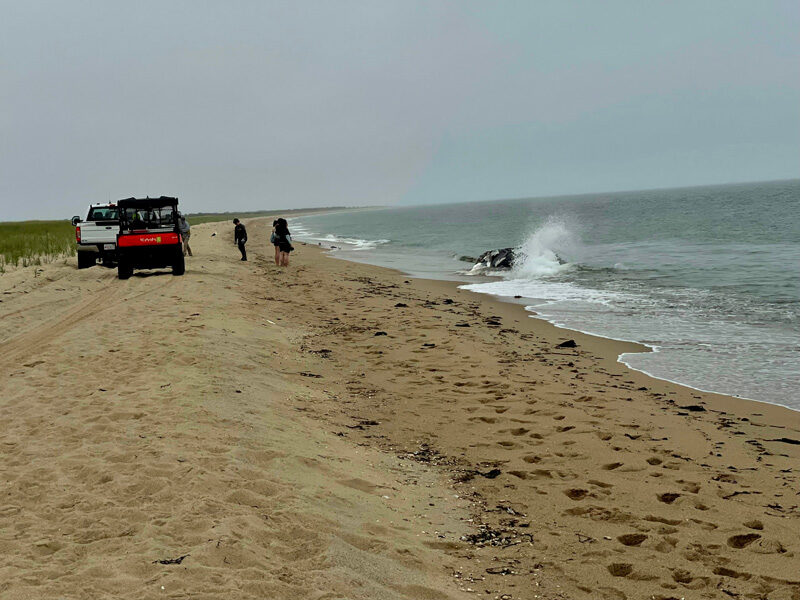
© Abigail RosenThe Trustees came out to take a look at the dead humpback whale.
Two dead whales have been found on Edgartown beaches this week.
Both have been identified by the National Oceanic and Atmospheric Administration (NOAA) as humpback whales.
On Monday, a partially decomposed humpback was found in Edgartown near Crackatuxet Cove; the second was discovered by beachgoers at East Beach on Chappaquiddick Tuesday morning.
It is unclear at this time what caused the deaths.
NOAA Fisheries' representatives say it's unlikely that there will be internal examinations to determine cause of death, considering the levels of decomposition. Both whales are estimated to have been dead for at least a few days.
Ainsley Smith, Marine Mammal Stranding Coordinator for the Greater Atlantic Regional Fisheries Office at NOAA, told
The Times that from data collected, many of the deceased humpback whales reported in the region over recent years looked to have been either struck by a vessel or had injuries consistent with blunt force or sharp force trauma.
"That was something consistent we were seeing in a number of those whales," Smith said.
This does not include reported dead humpbacks that were either too decomposed to determine cause of death or located far offshore.
According to NOAA, east coast and Mid-Atlantic waters have experienced an anomalous elevated humpback whale mortality rate since 2016 — around the same time the Western North Atlantic humpback was delisted from endangered to threatened.
This triggered the 2017 declaration of an Unusual Mortality Event (UME) in order to encourage population growth.
An estimated 40 percent of the nearly 200 humpback whale deaths reported over the last eight years from Maine to Florida showed evidence of human interaction via vessel strikes or equipment entanglement.
NOAA officials say that the organization has been in communication with the beach property owners, The Trustees of Reservations (TTOR). The Trustees began cordoning off the East Beach area Tuesday morning.
TTOR staff later collected a skin sample after documenting basic data for NOAA. According to that preliminary investigation, the whale is estimated to be 31.5 feet long.
Smith says based on pictures she's received of both humpbacks found on East Beach and South Beach, it's likely they've been dead for at least a couple of days.
NOAA communications specialist Andrea Gomez told
The Times that the organization may be able to get assistance from local partners to do an internal exam of the marine mammal. She says plans "are still being developed."
According to local animal control, it will be impossible to perform a necropsy or collect further data on the whale found near Crackatuxet.
NOAA says plans are being developed to consider onsite burial.
Although the Wampanoag Tribe of Gay Head (Aquinnah) is an authorized responder to stranded marine life reports, NOAA is "leading the logistics" for both cases.
Reports over the weekend of humpback whales breaching out of the water off South Beach have likely no correlation with the dead marine mammal found Monday and Tuesday, NOAA says. Healthy, normal behavior of the animals is acrobatic and lively in nature — consistent with what witnesses on South Beach reported over the weekend.
When asked if there's been any indication whether current and ongoing offshore and subsurface construction could be to blame for the fatalities, Smith said "at this point we are not aware of any ties between wind development and the death of the whales in the Mid-Atlantic."
Meanwhile, the corpse of what seems to be a dolphin was spotted on Moshup Beach in Aquinnah.
The Times reached out to NOAA for identification of the animal but have not received an answer yet.
Eunki Seonwoo contributed to this report
Reader Comments
to our Newsletter